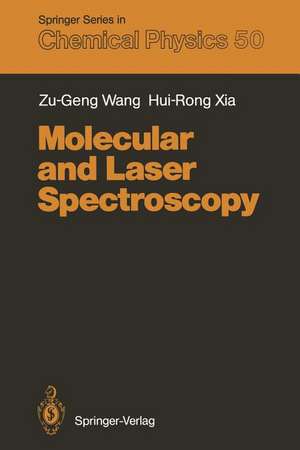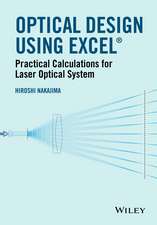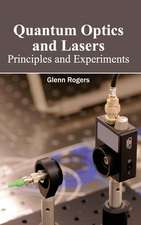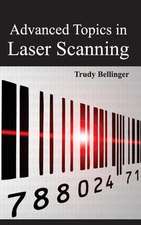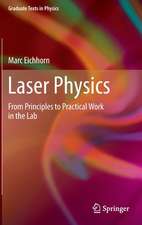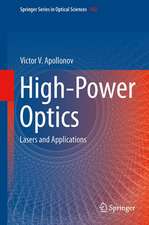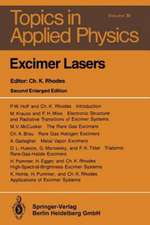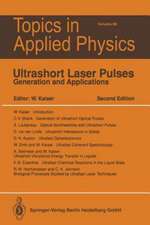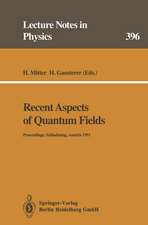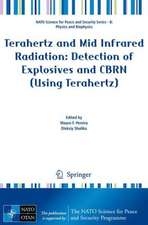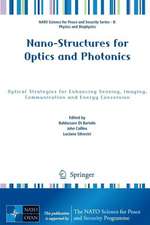Molecular and Laser Spectroscopy: Springer Series in Chemical Physics, cartea 50
Autor Zu-Geng Wang Arthur L. Schawlow Autor Hui-Rong Xiaen Limba Engleză Paperback – 8 dec 2011
Din seria Springer Series in Chemical Physics
- 20%
 Preț: 585.29 lei
Preț: 585.29 lei - 15%
 Preț: 643.00 lei
Preț: 643.00 lei - 15%
 Preț: 635.96 lei
Preț: 635.96 lei - 18%
 Preț: 953.03 lei
Preț: 953.03 lei - 15%
 Preț: 644.63 lei
Preț: 644.63 lei - 15%
 Preț: 638.43 lei
Preț: 638.43 lei - 15%
 Preț: 649.22 lei
Preț: 649.22 lei - 15%
 Preț: 647.40 lei
Preț: 647.40 lei - 15%
 Preț: 638.89 lei
Preț: 638.89 lei - 15%
 Preț: 652.31 lei
Preț: 652.31 lei - 15%
 Preț: 638.43 lei
Preț: 638.43 lei - 15%
 Preț: 637.13 lei
Preț: 637.13 lei - 18%
 Preț: 952.57 lei
Preț: 952.57 lei - 18%
 Preț: 947.85 lei
Preț: 947.85 lei - 15%
 Preț: 636.45 lei
Preț: 636.45 lei - 15%
 Preț: 649.87 lei
Preț: 649.87 lei - 18%
 Preț: 953.65 lei
Preț: 953.65 lei - 18%
 Preț: 894.03 lei
Preț: 894.03 lei - 15%
 Preț: 647.27 lei
Preț: 647.27 lei - 18%
 Preț: 1249.00 lei
Preț: 1249.00 lei - 15%
 Preț: 646.30 lei
Preț: 646.30 lei - 18%
 Preț: 954.14 lei
Preț: 954.14 lei - 24%
 Preț: 1226.80 lei
Preț: 1226.80 lei - 18%
 Preț: 961.72 lei
Preț: 961.72 lei - 18%
 Preț: 1002.31 lei
Preț: 1002.31 lei - 24%
 Preț: 647.23 lei
Preț: 647.23 lei - 18%
 Preț: 888.49 lei
Preț: 888.49 lei - 18%
 Preț: 908.04 lei
Preț: 908.04 lei - 15%
 Preț: 641.38 lei
Preț: 641.38 lei - 15%
 Preț: 585.40 lei
Preț: 585.40 lei - 15%
 Preț: 639.90 lei
Preț: 639.90 lei - 18%
 Preț: 897.02 lei
Preț: 897.02 lei
Preț: 388.13 lei
Nou
Puncte Express: 582
Preț estimativ în valută:
74.27€ • 77.70$ • 61.70£
74.27€ • 77.70$ • 61.70£
Carte tipărită la comandă
Livrare economică 02-16 aprilie
Preluare comenzi: 021 569.72.76
Specificații
ISBN-13: 9783642837203
ISBN-10: 3642837204
Pagini: 296
Ilustrații: XI, 281 p.
Dimensiuni: 155 x 235 x 16 mm
Greutate: 0.42 kg
Ediția:Softcover reprint of the original 1st ed. 1991
Editura: Springer Berlin, Heidelberg
Colecția Springer
Seria Springer Series in Chemical Physics
Locul publicării:Berlin, Heidelberg, Germany
ISBN-10: 3642837204
Pagini: 296
Ilustrații: XI, 281 p.
Dimensiuni: 155 x 235 x 16 mm
Greutate: 0.42 kg
Ediția:Softcover reprint of the original 1st ed. 1991
Editura: Springer Berlin, Heidelberg
Colecția Springer
Seria Springer Series in Chemical Physics
Locul publicării:Berlin, Heidelberg, Germany
Public țintă
ResearchCuprins
1. Introduction.- 2. Molecular Energy States.- 2.1 The Molecular-Motion Equation, and the Hamiltonian Operator.- 2.2 Molecular Electronic States.- 2.3 Molecular Vibrational Levels.- 2.4 Molecular Rotational Levels.- 2.5 Molecular Vibration-Rotational Levels.- 2.6 Coupling of Molecular Rotation and Electronic Motion.- 2.7 Perturbations.- 2.8 Quadrupole Hyperfine Structure of Molecules.- 2.9 Magnetic Dipole Hyperfine Structure in Molecules.- 2.10 Isotopic Energy-Level Shifts.- 2.11 Molecular Rydberg States.- 3. Linear Molecular Spectroscopy.- 3.1 Infrared Pure-Rotational Spectra.- 3.2 Infrared Vibrational Spectra.- 3.3 Infrared Vibration-Rotational Spectra.- 3.4 Vibrational Band Systems of Diatomic Molecules.- 3.5 Rotational Spectra of Electronic Bands of Diatomic Molecules.- 3.6 Electric Quadrupole and Magnetic Dipole Hyperfine Spectra of Molecules.- 3.7 The Goals for Experimental Studies of Molecular Spectroscopy.- 3.8 Advances of Molecular Spectroscopy Through Linear Interaction of Molecules with Lasers.- 4. Spectral Characteristics of Molecular Two-Photon Transitions.- 4.1 Classification of Equal-Frequency Molecular Two-Photon Transitions.- 4.2 Excitation Probability of a Two-Photon Transition with One Near-Resonant Enhancing Level.- 4.3 Coarse Structure of Near-Resonantly Enhanced Molecular Two-Photon Absorption Spectra.- 4.4 Fine Structure of Near-Resonantly Enhanced Molecular Two-Photon Transitions.- 4.5 Line Shapes and Higher-Order Corrections for Near-Resonant Two-Photon Transitions in Three-Level Systems.- 4.6 Molecular Two-Photon Transitions Enhanced by Mixing Levels.- 4.7 Semiclassical Theory for a Two-Photon Transition in a Four-Level System.- 4.8 Coherent Effects on the Line Shape of a Near-Resonant Two-Photon Transition in a Four-Level System.- 5. MolecularNonlinear Uncoupling Spectra with Doppler-Free Spectroscopy.- 5.1 Doppler-Free Saturation Spectroscopy and Its Development.- 5.2 Doppler-Free Polarization Spectroscopy and Its Development.- 5.3 Doppler-Free Two-Photon Spectroscopy and Its Development.- 5.4 Superhigh-Resolution Spectroscopy with Separated Fields.- 5.5 Applications of Nonlinear High-Resolution Laser Spectroscopy to Studies of Molecular Spectra.- 6. Molecular Nonlinear Coupling Spectral Effects.- 6.1 Background.- 6.2 Nonlinear Coupled Interaction in Three-Level Systems.- 6.3 Nonlinear Coupled Interaction in Four-Level Systems.- 6.4 Stimulated Diffuse Band Radiation via Various Excitation Processes.- 6.5 Stimulated and Coherent Radiation by Hybrid Excitation in Molecule-Atom Ensembles.- 6.6 Optically Pumped Stimulated Radiation Based on Molecular Electronic Transitions.- 6.7 Lasers Based on Molecular Photodissociation.- 6.8 Optically Pumped Far-Infrared Lasers Based on Pure Rotational Molecular Transitions.- 6.9 Optically Pumped Mid-Infrared Laser Based on Molecular Vibration-Rotational Transitions.- 6.10 Applications of Coherent Transient Spectroscopy in the Measurement of Molecular Parameters.- 7. Simplification and Identification of Molecular Spectra.- 7.1 Laser-Induced Fluorescence.- 7.2 Population Labelling.- 7.3 Polarization Labelling.- 7.4 Two-Step Polarization Labelling.- 7.5 Modulated Polarization Two-Photon Spectroscopy.- 7.6 Molecular Energy Level Information Provided by Selective Simplified Molecular Spectra.- 7.7 Comprehensive Identification of Equal-Frequency Molecular Two-Photon Transitions.- References.
